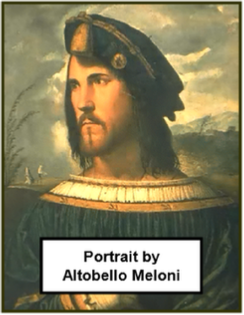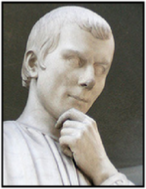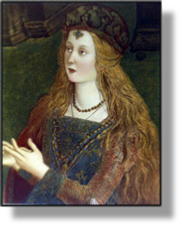


CESARE BORGIA c1475 -
xxxxxMembers of the Borgia family were descendants of a noble line, originating from Valencia in Spain. Alfonso Borgia established the family in Italy in the early part of the fifteenth century and, playing a prominent part in church and political affairs, was elected Pope as Calixtus III in 1455. Such was his power and influence that his nephew, Rodrigo, was also elected to this office in 1492, taking the title Alexander VI.
xxxxxOne  of the most prominent and most notorious members of the family was Rodrigo’s illegitimate son Cesare Borgia, a name which, with some justification, has become associated with ruthlessness, cunning and intrigue. After a misspent youth, during which he studied canon and civil law at Pisa University, he entered the church -
of the most prominent and most notorious members of the family was Rodrigo’s illegitimate son Cesare Borgia, a name which, with some justification, has become associated with ruthlessness, cunning and intrigue. After a misspent youth, during which he studied canon and civil law at Pisa University, he entered the church -
xxxxxBut Cesare was not content with ecclesiastical life, as debauched and remunerative as this could be in those days. Arrogant and ambitious, he now turned soldier and politician. He served the King of France, Louis XII, for a short time, gaining the title of the Duke of Valentinois (hence his nickname Il Valentino) and then, under the guise of assisting his father to re-
xxxxxIt was during this period, above all, that he gained his reputation for being the most cunning, ruthless and treacherous of the petty leaders (“Princes”) of the Italian Renaissance, prone to fits of violent temper and totally unpredictable. As early as 1497 he was suspected of murdering his brother, Juan. This was never proven, but in 1500 he was clearly responsible for the killing of the Duke of Bisceglie, second husband to his sister Lucrezia. Two years later, when he faced a rebellion during his campaign in central Italy, he lured his principal opponents to peace talks at the castle of Sinigaglia and then promptly executed them.
xxxxxIt was,  in fact, during this time that the political philosopher Machiavelli (illustrated), acting as one of the Florentine ambassadors attached to Cesare’s camp, was able to observe at first hand the character of the man he was to dub his “Prince”. Furthermore, he was a witness to the treachery and killings at Sinigaglia castle and later wrote his famous account of the incident entitled, On the Manner Adopted by the Duke Valentino to Kill Vitellozzo.
in fact, during this time that the political philosopher Machiavelli (illustrated), acting as one of the Florentine ambassadors attached to Cesare’s camp, was able to observe at first hand the character of the man he was to dub his “Prince”. Furthermore, he was a witness to the treachery and killings at Sinigaglia castle and later wrote his famous account of the incident entitled, On the Manner Adopted by the Duke Valentino to Kill Vitellozzo.
xxxxxWith the death of his father in 1503 Cesare’s fortunes went into free-
xxxxxCesare was by no means a first-
xxxxxIncidentally, for almost a year Cesare Borgia had in his employ the young Leonardo da Vinci. In 1502, clearly anxious to live life to the full, this master-
xxxxxAlfonso Borgia established the noble Borgia family in Italy early in the 15th century, and was made pope as Calixtus III in 1455. By his influence, his nephew Rodrigo was also made pope as Alexander VI in 1492. Rodrigo's illegitimate son, Cesare Borgia, known for his ruthlessness and cunning, was appointed a Cardinal in 1493, at the age of 18, and then, in the guise of helping his father, intrigued and murdered to gain control of a vast area of central and northern Italy. It was at this time that the political philosopher Machiavelli, attached to Cesare's camp, observed at first hand the man he was to dub his "Prince" (1513 H8). With the death of his father, Cesare fell from favour and fled to Naples. Imprisoned for planning to overthrow the new pope, he escaped, but was killed in 1507 during an expedition against Castile.
Including:
Lucrezia
Borgia

xxxxxCesare’s sister, Lucrezia Borgia (1480-
 xxxxxA great deal of the sleaze associated with the Borgia family has clearly rubbed off onto Cesare's sister Lucrezia Borgia (1480-
xxxxxA great deal of the sleaze associated with the Borgia family has clearly rubbed off onto Cesare's sister Lucrezia Borgia (1480-
xxxxxThe third marriage, to Alfonso I, Duke of Ferrara, was arranged in 1501 to consolidate her brother’s hold on the Romagna, but it proved valuable in another direction. Following the death of her father, Pope Alexander VI, in 1503, she ceased to play a part in politics, and from 1505 devoted her time to setting up a brilliant court in the city of Ferrara. Under her guidance and assisted by her husband, this became a centre of Renaissance art and letters, and included the Italian poet Ludovico Ariosto (noted for his epic poem Orlando Furioso) and the two outstanding Venetian painters Giovanni Bellini and Titian.



Acknowledgements
Cesare: portrait by the Italian Renaissance painter Altobello Meloni (c1490-
H7-